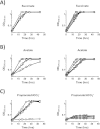Transcriptional Regulation by the Short-Chain Fatty Acyl Coenzyme A Regulator (ScfR) PccR Controls Propionyl Coenzyme A Assimilation by Rhodobacter sphaeroides
- PMID: 26170412
- PMCID: PMC4560284
- DOI: 10.1128/JB.00402-15
Transcriptional Regulation by the Short-Chain Fatty Acyl Coenzyme A Regulator (ScfR) PccR Controls Propionyl Coenzyme A Assimilation by Rhodobacter sphaeroides
Abstract
Propionyl coenzyme A (propionyl-CoA) assimilation by Rhodobacter sphaeroides proceeds via the methylmalonyl-CoA pathway. The activity of the key enzyme of the pathway, propionyl-CoA carboxylase (PCC), was upregulated 20-fold during growth with propionate compared to growth with succinate. Because propionyl-CoA is an intermediate in acetyl-CoA assimilation via the ethylmalonyl-CoA pathway, acetate growth also requires the methylmalonyl-CoA pathway. PCC activities were upregulated 8-fold in extracts of acetate-grown cells compared to extracts of succinate-grown cells. The upregulation of PCC activities during growth with propionate or acetate corresponded to increased expression of the pccB gene, which encodes a subunit of PCC. PccR (RSP_2186) was identified to be a transcriptional regulator required for the upregulation of pccB transcript levels and, consequently, PCC activity: growth substrate-dependent regulation was lost when pccR was inactivated by an in-frame deletion. In the pccR mutant, lacZ expression from a 215-bp plasmid-borne pccB upstream fragment including 27 bp of the pccB coding region was also deregulated. A loss of regulation as a result of mutations in the conserved motifs TTTGCAAA-X4-TTTGCAAA in the presence of PccR allowed the prediction of a possible operator site. PccR, together with homologs from other organisms, formed a distinct clade within the family of short-chain fatty acyl coenzyme A regulators (ScfRs) defined here. Some members from other clades within the ScfR family have previously been shown to be involved in regulating acetyl-CoA assimilation by the glyoxylate bypass (RamB) or propionyl-CoA assimilation by the methylcitrate cycle (MccR).
Importance: Short-chain acyl-CoAs are intermediates in essential biosynthetic and degradative pathways. The regulation of their accumulation is crucial for appropriate cellular function. This work identifies a regulator (PccR) that prevents the accumulation of propionyl-CoA by controlling expression of the gene encoding propionyl-CoA carboxylase, which is responsible for propionyl-CoA consumption by Rhodobacter sphaeroides. Many other Proteobacteria and Actinomycetales contain one or several PccR homologs that group into distinct clades on the basis of the pathway of acyl-CoA metabolism that they control. Furthermore, an upstream analysis of genes encoding PccR homologs allows the prediction of conserved binding motifs for these regulators. Overall, this study evaluates a single regulator of propionyl-CoA assimilation while expanding the knowledge of the regulation of short-chain acyl-CoAs in many bacterial species.
Copyright © 2015, American Society for Microbiology. All Rights Reserved.
Figures





Similar articles
-
Rhodobacter sphaeroides uses a reductive route via propionyl coenzyme A to assimilate 3-hydroxypropionate.J Bacteriol. 2012 Jan;194(2):225-32. doi: 10.1128/JB.05959-11. Epub 2011 Nov 4. J Bacteriol. 2012. PMID: 22056933 Free PMC article.
-
AccR, a TetR Family Transcriptional Repressor, Coordinates Short-Chain Acyl Coenzyme A Homeostasis in Streptomyces avermitilis.Appl Environ Microbiol. 2020 Jun 2;86(12):e00508-20. doi: 10.1128/AEM.00508-20. Print 2020 Jun 2. Appl Environ Microbiol. 2020. PMID: 32303550 Free PMC article.
-
Acrylyl-coenzyme A reductase, an enzyme involved in the assimilation of 3-hydroxypropionate by Rhodobacter sphaeroides.J Bacteriol. 2013 Oct;195(20):4716-25. doi: 10.1128/JB.00685-13. Epub 2013 Aug 16. J Bacteriol. 2013. PMID: 23955006 Free PMC article.
-
Biotechnological potential of the ethylmalonyl-CoA pathway.Appl Microbiol Biotechnol. 2011 Jan;89(1):17-25. doi: 10.1007/s00253-010-2873-z. Epub 2010 Sep 30. Appl Microbiol Biotechnol. 2011. PMID: 20882276 Review.
-
Directed Evolution of Propionyl-CoA Carboxylase for Succinate Biosynthesis.Trends Biotechnol. 2021 Apr;39(4):330-331. doi: 10.1016/j.tibtech.2021.02.006. Epub 2021 Feb 22. Trends Biotechnol. 2021. PMID: 33632542 Review.
Cited by
-
Metabolic pathways to sustainability: review of purple non-sulfur bacteria potential in agri-food waste valorization.Front Bioeng Biotechnol. 2025 Feb 24;13:1529032. doi: 10.3389/fbioe.2025.1529032. eCollection 2025. Front Bioeng Biotechnol. 2025. PMID: 40066363 Free PMC article. Review.
-
Recruitment of Mobile Genetic Elements for Diverse Cellular Functions in Prokaryotes.Front Mol Biosci. 2022 Mar 24;9:821197. doi: 10.3389/fmolb.2022.821197. eCollection 2022. Front Mol Biosci. 2022. PMID: 35402511 Free PMC article. Review.
-
TetR Family Transcriptional Regulator PccD Negatively Controls Propionyl Coenzyme A Assimilation in Saccharopolyspora erythraea.J Bacteriol. 2017 Sep 19;199(20):e00281-17. doi: 10.1128/JB.00281-17. Print 2017 Oct 15. J Bacteriol. 2017. PMID: 28760847 Free PMC article.
-
Comprehensive Review Regarding Mercury Poisoning and Its Complex Involvement in Alzheimer's Disease.Int J Mol Sci. 2022 Feb 11;23(4):1992. doi: 10.3390/ijms23041992. Int J Mol Sci. 2022. PMID: 35216107 Free PMC article. Review.
-
GlnR-Mediated Regulation of Short-Chain Fatty Acid Assimilation in Mycobacterium smegmatis.Front Microbiol. 2018 Jun 22;9:1311. doi: 10.3389/fmicb.2018.01311. eCollection 2018. Front Microbiol. 2018. PMID: 29988377 Free PMC article.
References
-
- Imhoff JF. 2005. Genus I. Rhodobacter Imhoff, Trüper and Pfennig 1984, 342VP, p 164 In Brenner DJ, Krieg NR, Staley JT, Garrity GM (ed), Bergey's manual of systematic bacteriology, 2nd ed, vol 2 Springer, New York, NY.
Publication types
MeSH terms
Substances
LinkOut - more resources
Full Text Sources

